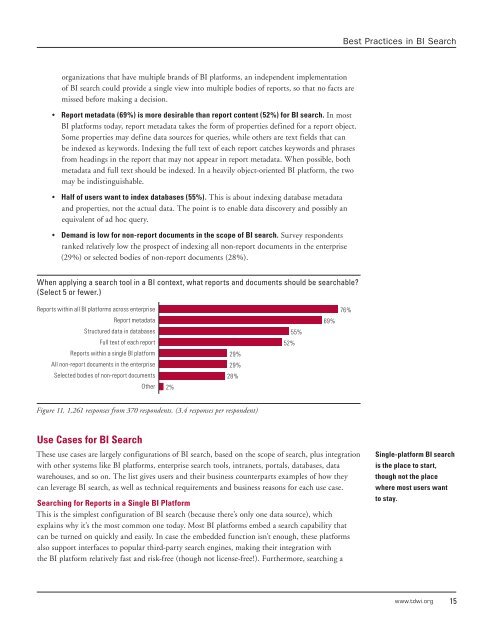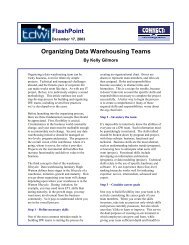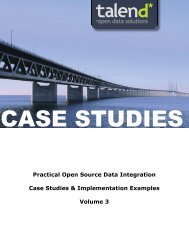BI SEARCH AND TEXT ANALYTICS - The Data Warehousing Institute
BI SEARCH AND TEXT ANALYTICS - The Data Warehousing Institute
BI SEARCH AND TEXT ANALYTICS - The Data Warehousing Institute
Create successful ePaper yourself
Turn your PDF publications into a flip-book with our unique Google optimized e-Paper software.
Best Practices in <strong>BI</strong> Searchorganizations that have multiple brands of <strong>BI</strong> platforms, an independent implementationof <strong>BI</strong> search could provide a single view into multiple bodies of reports, so that no facts aremissed before making a decision.• Report metadata (69%) is more desirable than report content (52%) for <strong>BI</strong> search. In most<strong>BI</strong> platforms today, report metadata takes the form of properties defined for a report object.Some properties may define data sources for queries, while others are text fields that canbe indexed as keywords. Indexing the full text of each report catches keywords and phrasesfrom headings in the report that may not appear in report metadata. When possible, bothmetadata and full text should be indexed. In a heavily object-oriented <strong>BI</strong> platform, the twomay be indistinguishable.• Half of users want to index databases (55%). This is about indexing database metadataand properties, not the actual data. <strong>The</strong> point is to enable data discovery and possibly anequivalent of ad hoc query.• Demand is low for non-report documents in the scope of <strong>BI</strong> search. Survey respondentsranked relatively low the prospect of indexing all non-report documents in the enterprise(29%) or selected bodies of non-report documents (28%).When applying a search tool in a <strong>BI</strong> context, what reports and documents should be searchable?(Select 5 or fewer.)Figure 11. 1,261 responses from 370 respondents. (3.4 responses per respondent)Use Cases for <strong>BI</strong> Search<strong>The</strong>se use cases are largely configurations of <strong>BI</strong> search, based on the scope of search, plus integrationwith other systems like <strong>BI</strong> platforms, enterprise search tools, intranets, portals, databases, datawarehouses, and so on. <strong>The</strong> list gives users and their business counterparts examples of how theycan leverage <strong>BI</strong> search, as well as technical requirements and business reasons for each use case.Searching for Reports in a Single <strong>BI</strong> PlatformThis is the simplest configuration of <strong>BI</strong> search (because there’s only one data source), whichexplains why it’s the most common one today. Most <strong>BI</strong> platforms embed a search capability thatcan be turned on quickly and easily. In case the embedded function isn’t enough, these platformsalso support interfaces to popular third-party search engines, making their integration withthe <strong>BI</strong> platform relatively fast and risk-free (though not license-free!). Furthermore, searching aSingle-platform <strong>BI</strong> searchis the place to start,though not the placewhere most users wantto stay.www.tdwi.org 15















![Ink Jet Formulation- The Art of Color Chemistry 2005 [Read-Only]](https://img.yumpu.com/42062450/1/190x143/ink-jet-formulation-the-art-of-color-chemistry-2005-read-only.jpg?quality=85)
